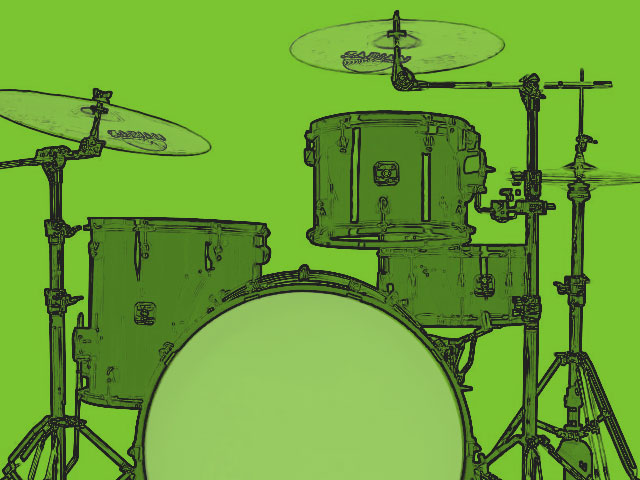- Published Aug 10, 2013 in In The Studio
In Part 2, we’ll look at EQ techniques for each component of the kit from kick and snare to overheads and ambient room mics.
First, a word about EQ: with a parametric EQ I’ll set a very mild to tight Q, decrease by 5 db and then scan the frequency range to see if a frequency range being “cut” (diminished/reduced) makes that instrument sound better. This is called “negative EQ”. If I find something I like, I’ll widen or tighten and decrease the amount, or add once I’ve found a range that needs to be fought off like a mongrel horde.
Spend a little time doing this. Don’t just add, try taking some away! Remember also that what sounds good in solo mode may make little difference when the rest of the mics are in. Conversely, something that sounds like crap in solo mode could sound really great when the other mics are in.
Think of it like sugar. A big spoon full of it isn’t gonna be that pleasant (you might have a sugar problem if it is) but add some to your batter and your cake will taste better. Each mic is an element of the whole – keep this in mind.
Kick and snare.
Now add EQ to the kick. Start by increasing the 3kHz to 6kHz range. You should have more “tap” than sounds good in solo mode – it should sound almost too “tappy”. Take away a little bit at 300hz and add some bellow 100hz – but not too much.
If you have multiple mics on the snare, do the same thing you just did to the kick mics. In the EQ range you’ll want to add some at 6k to 10k and more at 2k. Be delicate on where and how much of the lows you take away.
You might also find a gate useful. A gate is just that, a door that opens or closes. At what level the gate opens and for how long is what you’ll control. Sometimes you’ll just let the attack of the snare through the gate and let it close rapidly. This can be very useful to keep other instruments out that were bleeding into your snare mic(s) and allows you to really increase the snare level without also turning up all the bleed and ring for the other drum/cymbals.
You can insert the gate after EQ or before compression; it’s a matter of what gets the gate opening and closing more efficiently.
Hi Hat.
Here I add a little compression and then EQ. I take away a lot of frequency below 300Hz and add between 2k and 12k.
Rack and floor toms.
Toms I generally do not compress, but add a little EQ at 100Hz and 4k. I pan them according to how I want the listener to experience it—either from the drummer’s perspective or from the audience’s perspective. I prefer the audience perspective which means, with a right handed drummer, the floor tom is panned left, just as it would be looking at a kit from the front. Not hard left but middle left. Rack tom, panned right but more towards center than the floor tom is.
You checked phase right?
Overheads.
If I’m doing a jazz record then I only compress the overheads a little and try to have a really good overall sound from them—they will be 75 percent of your whole kit sound. On rock records, you’ll want to be more aggressive with them. Bus the two overhead mics to a stereo bus/group and pan the individual mic channels depending on the perspective you want—hard left and hard right or less severe.
Compress and then EQ. I like to take away almost everything below 250Hz and accentuate the 6k to 10k range. This makes the cymbals jump out, which is what you’re trying to capture by these mics.
Room/Ambient mics.
I squash the living crap out of rooms. I beat them down, I put a hurtin’ on ‘em. It’s violent and ugly and so amazingly wonderful.
Take a compressor, set the ratio between 10:1 and 20:1 with a very slow attack and a very fast release. I make the input needle say uncle, peg it and then adjust the output to add more volume that I just took away with all that compression.
I look for a pumping sound and to make sure the snare really pops and sounds like a cannon. You’ll have to be careful because cymbals will also boost, so it’s a balancing act. I either don’t EQ or I’ll take away everything below 100Hz—depends how it’s fitting in with the other mics. Blend to taste!

